Quadrilaterals
Categories: gcse geometry
Level:

A quadrilateral is a shape with four straight sides.
The interior angles of any quadrilateral add up to 360 degrees.
There are various types of quadrilaterals that have special names:
- Square
- Rectangle
- Parallelogram
- Rhombus
- Trapezium
- Kite
Here is a video about quadrilaterals
Square
A square is a quadrilateral where all four sides are equal, and all four angles are 90 degrees

The tick marks on the four sides indicate that the sides are the same length.
The square angle symbols in the corners indicate that each corner is a 90-degree angle.
Rectangle
A rectangle is a quadrilateral that has all four angles equal to 90 degrees.

The opposite sides of a rectangle are always equal.
A square is a special type of rectangle, where all four sides are equal.
Parallelogram
A parallelogram is a quadrilateral where both pairs of opposite sides are parallel. You can think of a parallelogram as a "pushed-over" rectangle.

The opposite sides of a parallelogram have equal lengths.
The diagonally opposite angles are equal.
A rectangle is a special type of parallelogram where all 4 angles are 90 degrees.
Rhombus
A rhombus is a quadrilateral where all four sides are the same length, and both pairs of opposite sides are parallel. You can think of a rhombus as a "pushed-over" square.
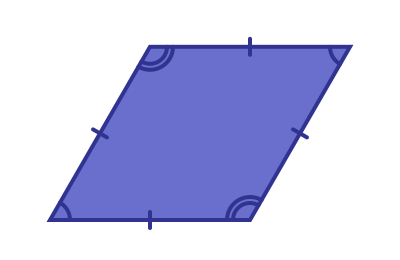
A rhombus is a special type of parallelogram where all four sides are equal. The diagonally opposite angles of a rhombus are equal.
If you rotate a rhombus you will see a shape that is sometimes called a diamond. It is the same shape, just rotated.

Trapezium
A trapezium is a quadrilateral that has at least two parallel sides
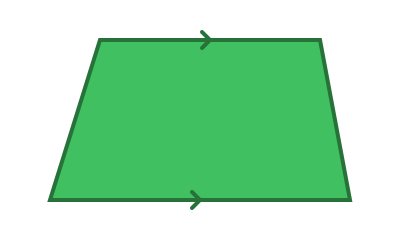
There are several types of trapezium.
Acute trapezium
An acute trapezium is a trapezium where both angles at the base are acute (that is, less than 90 degrees). It is like a slice through an acute triangle.
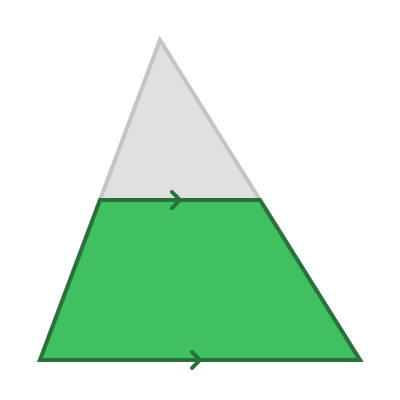
Notice that the sides slope in opposite directions.
Obtuse trapezium
An obtuse trapezium is a trapezium where one of the angles at the base is obtuse (that is, greater than 90 degrees). It is like a slice through an obtuse triangle.
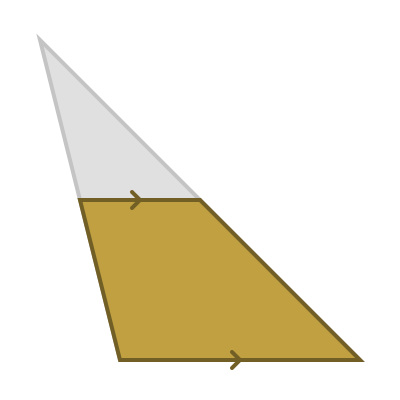
Notice that one side slopes inwards, and one slopes outwards.
Right-angled trapezium
A right-angled trapezium is a trapezium where one of the angles at the base is a right angle. It is like a slice through a right-angled triangle.
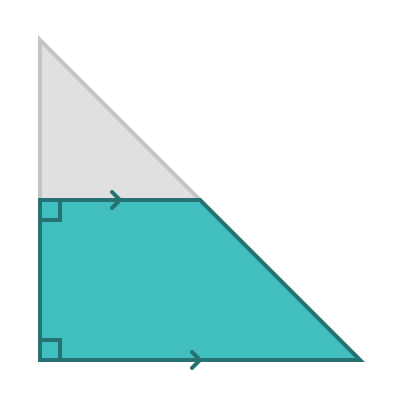
Isosceles trapezium
An isosceles trapezium is one where the two sides make the same angle to the base (but with opposite directions of slope).
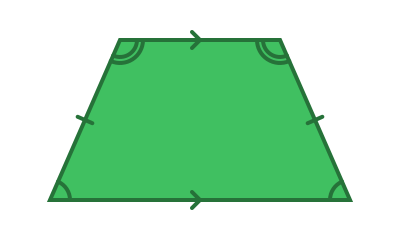
The two sides of an isosceles trapezium are of equal length. An isosceles trapezium is like a slice through an isosceles triangle.
Trapezium with three equal sides
A special case of the isosceles trapezium is one where three of the sides are equal in length:
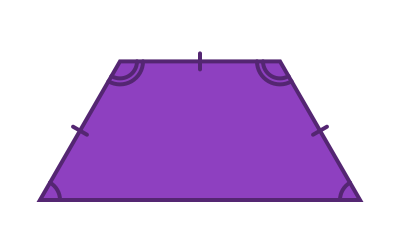
Kite
A kite is a quadrilateral that has two pairs of equal-length sides that are adjacent to each other (that is, next to each other).

The opposite angles of a kite are equal, as shown.
A rhombus is a special case of a kite where the lengths of all four sides are equal.
Right kite
A kite always has two equal angles - the angles between a short and long side. A right kite is a special case where those angles are right angles.
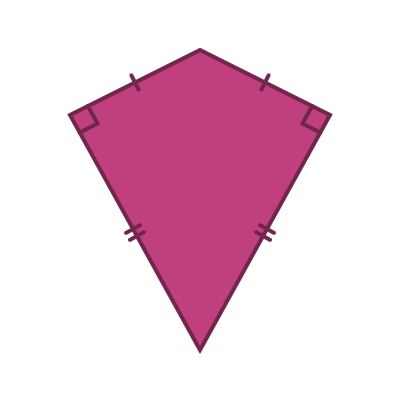
An interesting fact about right kites is they are cyclic - you can draw a circle that touches all four corners.

Related articles
- Regular polygons
- Interior and exterior angles of a polygon
- Triangles
- Quadrilateral family tree
- Pentagons - polygons with 5 sides
- Hexagons - polygons with 6 sides
- Heptagons - polygons with 7 sides
- Octagons - polygons with 8 sides
- Nonagons - polygons with 9 sides
- Decagons - polygons with 10 sides
- Hendecagons - polygons with 11 sides
- Dodecagons - polygons with 12 sides
- n-gons - polygons with any number of sides
- Other types of polygon
- Star polygons
Join the GraphicMaths Newsletter
Sign up using this form to receive an email when new content is added to the graphpicmaths or pythoninformer websites:

Popular tags
adder adjacency matrix alu and gate angle answers area argand diagram binary maths cardioid cartesian equation chain rule chord circle cofactor combinations complex modulus complex numbers complex polygon complex power complex root cosh cosine cosine rule countable cpu cube decagon demorgans law derivative determinant diagonal directrix dodecagon e eigenvalue eigenvector ellipse equilateral triangle erf function euclid euler eulers formula eulers identity exercises exponent exponential exterior angle first principles flip-flop focus gabriels horn galileo gamma function gaussian distribution gradient graph hendecagon heptagon heron hexagon hilbert horizontal hyperbola hyperbolic function hyperbolic functions infinity integration integration by parts integration by substitution interior angle inverse function inverse hyperbolic function inverse matrix irrational irrational number irregular polygon isomorphic graph isosceles trapezium isosceles triangle kite koch curve l system lhopitals rule limit line integral locus logarithm maclaurin series major axis matrix matrix algebra mean minor axis n choose r nand gate net newton raphson method nonagon nor gate normal normal distribution not gate octagon or gate parabola parallelogram parametric equation pentagon perimeter permutation matrix permutations pi pi function polar coordinates polynomial power probability probability distribution product rule proof pythagoras proof quadrilateral questions quotient rule radians radius rectangle regular polygon rhombus root sech segment set set-reset flip-flop simpsons rule sine sine rule sinh slope sloping lines solving equations solving triangles square square root squeeze theorem standard curves standard deviation star polygon statistics straight line graphs surface of revolution symmetry tangent tanh transformation transformations translation trapezium triangle turtle graphics uncountable variance vertical volume volume of revolution xnor gate xor gate
